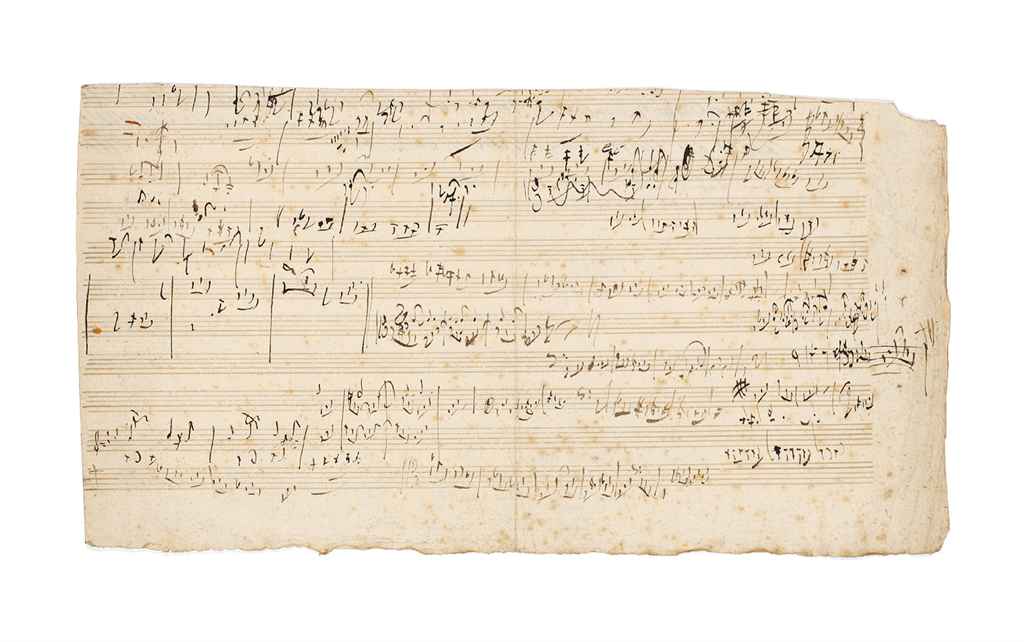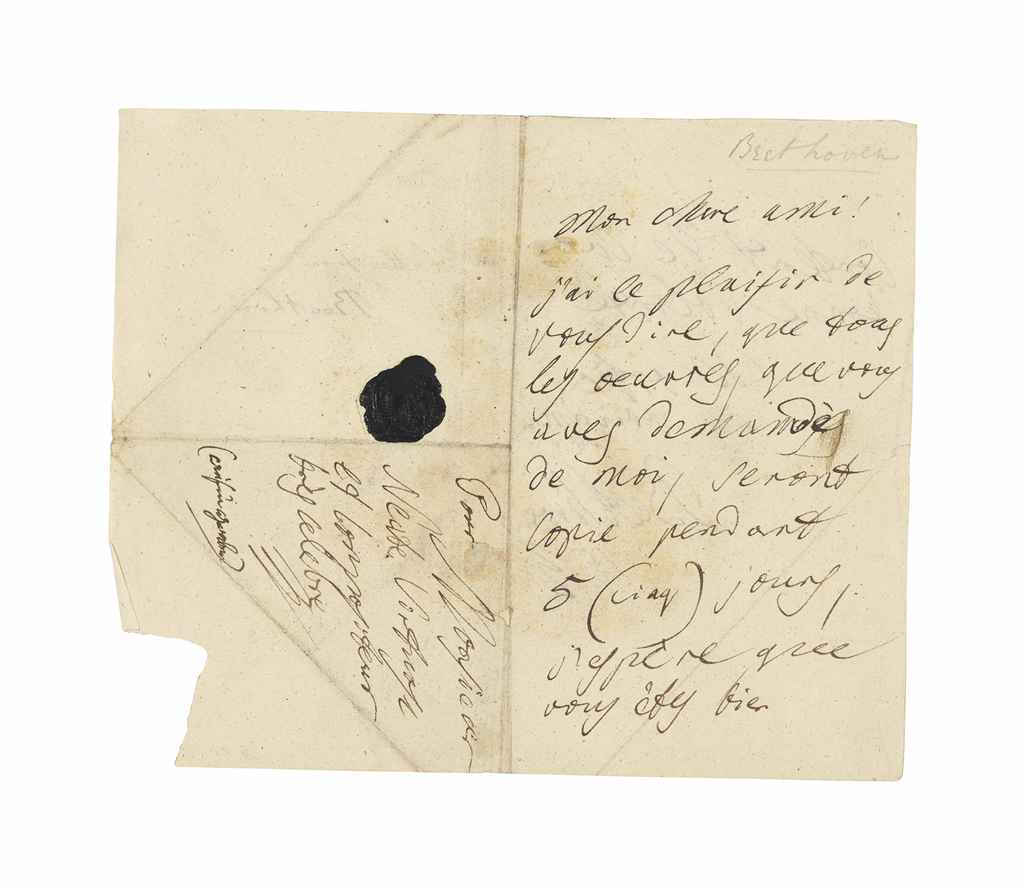BEETHOVEN, Ludwig van (1770-1827). AUTOGRAPH MANUSCRIPT OF SKETCHES FOR DIE WEIHE DES HAUSES , opus 124, four pages, 32 bars, two systems of eight staves per page, black ink and pencil, later yellow morocco with the title stamped in gilt on black with black and gilt decorated border, with autograph letters of Josef Ludwig identifying the work, 1½ pages, Maida Hill, 17 July 1893, and from the Royal College of Music, recommending that the manuscript is shown to the renowned Beethoven scholar J.S.Shedlock, 4 pages, London, 7 June 1893, tipped in to the inner front cover, together with autograph letters of J. S. Shedlock commenting on the sketch and the other versions of the work, 2 pages, London, 2 August 1893, an incomplete autograph letter of Arthur Hill referring to the sale of the manuscript and stating that Ludwig hoped that the sketch could go to the Beethoven Museum in Bonn, 1½ pages, [London, early summer 1894], an autograph letter of OTTO GOLDSCHMIDT, discussing the prices of this manuscript and others for more than 30 years in the possession of my late wife to be sold by Messrs Puttick and Simpson, 4 pages, London, 24 April 1894, and the catalogue entry for this sketch at the Worshipful Company of Musicians' Loan Exhibition of Ancient Musical Instruments, Manuscripts, Portraits, Books, Etc., June-July 1904, (no. 483a), pasted on the headed paper of the exhibition committee, all loose, oblong quarto, 244 x 310mm., (slight discoloration and foxing, some fraying to the bottom edge, vertical creases), [Baden, September 1822] Die Weihe des Hauses overture was written for the opening of the Josefstadt Theater on 3 October 1822. Beethoven only began work the previous month, however, having been told on 2 September by the impresario Karl Friedrich Hensler that the theatre would be inaugurated with a performance of Beethoven's music. Beethoven wrote on 13 September I had hardly arrived here [Baden] when I met a theatrical manager who is building a theatre in Vienna which he is opening with one of my compositions. So to please him I have had to compose a few new movements . A few days later he wrote to his brother the Theater in der Josefstadt has given me some work to do here, which is really very difficult to fit in with my water and bath cures...Meanwhile I have already composed a new chorus...If my health permits, I will compose another new overture . (Emily Anderson, The Letters of Beethoven , 3 vols., London, 1961, nos. 1100 and 1101). The present sketch therefore dates from this period of unaccustomedly speedy work during what was supposed to be a rest cure at the spa. In fact the play for the opening of the theatre was an adaption by Carl Meisl of Kotzbue's Die Ruinen von Athen which had been given in Pest on 10 February 1812 and for which Beethoven had written the incidental music (op.113). The new movements to which Beethoven refers were the overture (op.124) and the chorus with solo soprano and violin Wo sich die Pulse (WoO 98). The other music was revised from Die Ruinen , including the March which on its own became op.114. Anton Schindler, Beethoven's biographer, tells of walks with Beethoven over the hills near Baden while Beethoven jotted down themes for the overture. These jottings were scrawled in pencil on leaves of manuscript which were then folded and thrust into Beethoven's pocket resulting in the characteristic vertical creases which can be seen in the present manuscript. Schindler also tells us that Beethoven had long wanted to write an overture in the strict style, specifically that of Handel whom Beethoven regarded as his mentor. The model which Beethoven had in mind was apparently Alexander's Feast , of which the overture and final chorus show distinct similarities to Beethoven's work. The present manuscript concerns the first part of the overture. The whole of the theme is sketched and notably the section with the solo trumpets and the ensuing bassoon counterpoint, which is slightly different in t
BEETHOVEN, Ludwig van (1770-1827). AUTOGRAPH MANUSCRIPT OF SKETCHES FOR DIE WEIHE DES HAUSES , opus 124, four pages, 32 bars, two systems of eight staves per page, black ink and pencil, later yellow morocco with the title stamped in gilt on black with black and gilt decorated border, with autograph letters of Josef Ludwig identifying the work, 1½ pages, Maida Hill, 17 July 1893, and from the Royal College of Music, recommending that the manuscript is shown to the renowned Beethoven scholar J.S.Shedlock, 4 pages, London, 7 June 1893, tipped in to the inner front cover, together with autograph letters of J. S. Shedlock commenting on the sketch and the other versions of the work, 2 pages, London, 2 August 1893, an incomplete autograph letter of Arthur Hill referring to the sale of the manuscript and stating that Ludwig hoped that the sketch could go to the Beethoven Museum in Bonn, 1½ pages, [London, early summer 1894], an autograph letter of OTTO GOLDSCHMIDT, discussing the prices of this manuscript and others for more than 30 years in the possession of my late wife to be sold by Messrs Puttick and Simpson, 4 pages, London, 24 April 1894, and the catalogue entry for this sketch at the Worshipful Company of Musicians' Loan Exhibition of Ancient Musical Instruments, Manuscripts, Portraits, Books, Etc., June-July 1904, (no. 483a), pasted on the headed paper of the exhibition committee, all loose, oblong quarto, 244 x 310mm., (slight discoloration and foxing, some fraying to the bottom edge, vertical creases), [Baden, September 1822] Die Weihe des Hauses overture was written for the opening of the Josefstadt Theater on 3 October 1822. Beethoven only began work the previous month, however, having been told on 2 September by the impresario Karl Friedrich Hensler that the theatre would be inaugurated with a performance of Beethoven's music. Beethoven wrote on 13 September I had hardly arrived here [Baden] when I met a theatrical manager who is building a theatre in Vienna which he is opening with one of my compositions. So to please him I have had to compose a few new movements . A few days later he wrote to his brother the Theater in der Josefstadt has given me some work to do here, which is really very difficult to fit in with my water and bath cures...Meanwhile I have already composed a new chorus...If my health permits, I will compose another new overture . (Emily Anderson, The Letters of Beethoven , 3 vols., London, 1961, nos. 1100 and 1101). The present sketch therefore dates from this period of unaccustomedly speedy work during what was supposed to be a rest cure at the spa. In fact the play for the opening of the theatre was an adaption by Carl Meisl of Kotzbue's Die Ruinen von Athen which had been given in Pest on 10 February 1812 and for which Beethoven had written the incidental music (op.113). The new movements to which Beethoven refers were the overture (op.124) and the chorus with solo soprano and violin Wo sich die Pulse (WoO 98). The other music was revised from Die Ruinen , including the March which on its own became op.114. Anton Schindler, Beethoven's biographer, tells of walks with Beethoven over the hills near Baden while Beethoven jotted down themes for the overture. These jottings were scrawled in pencil on leaves of manuscript which were then folded and thrust into Beethoven's pocket resulting in the characteristic vertical creases which can be seen in the present manuscript. Schindler also tells us that Beethoven had long wanted to write an overture in the strict style, specifically that of Handel whom Beethoven regarded as his mentor. The model which Beethoven had in mind was apparently Alexander's Feast , of which the overture and final chorus show distinct similarities to Beethoven's work. The present manuscript concerns the first part of the overture. The whole of the theme is sketched and notably the section with the solo trumpets and the ensuing bassoon counterpoint, which is slightly different in t








.jpg)
Try LotSearch and its premium features for 7 days - without any costs!
Be notified automatically about new items in upcoming auctions.
Create an alert